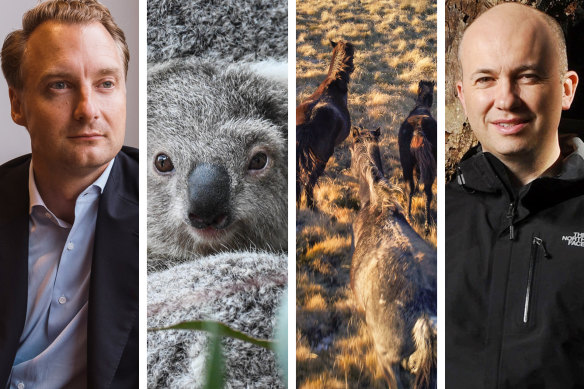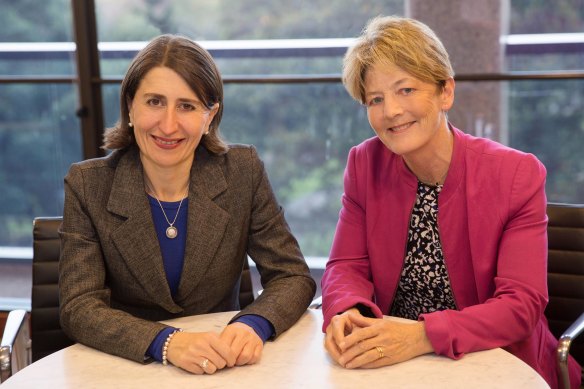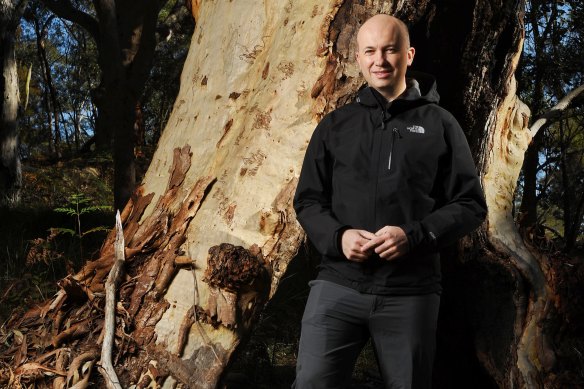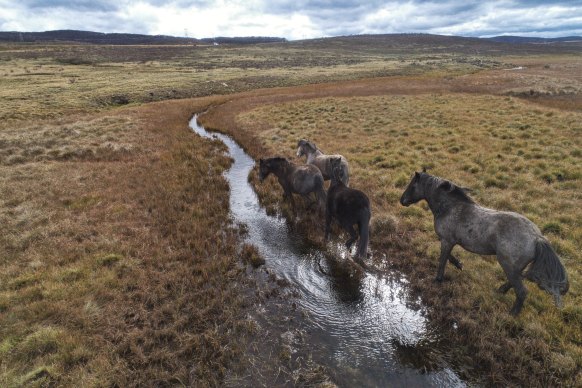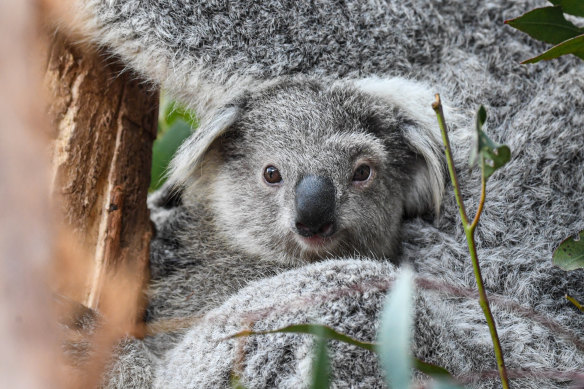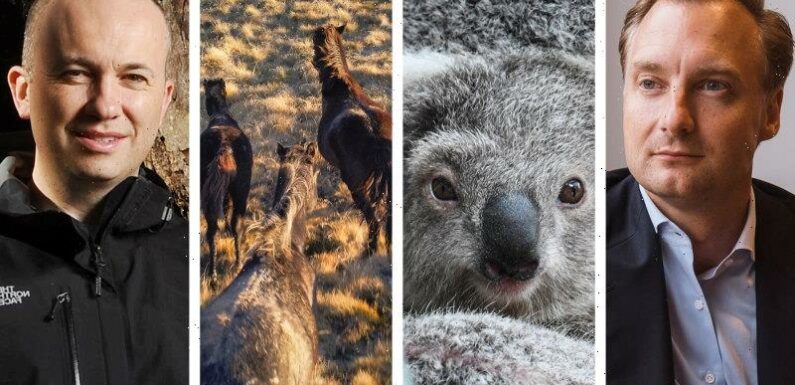
By Nick O'Malley and Laura Chung
Environment Minister James Griffin, left, and former environment minister Matt Kean, right. Declining koala populations and skyrocketing numbers of wild horses are dark spots on the Coalition’s environment record.Credit:James Brickwood, Peter Rae, Nick Moir
Even by the standards of Macquarie Street, the fight the former Liberal MP Catherine Cusack had in her office with Matt Kean one day in November 2020 was pretty ugly, at least the way she remembers it.
Back then, Kean, now treasurer and energy minister, held the portfolios of energy and environment.
The specific issue was koalas, but the significance of the moment, says Cusack today, was far broader. She believed it was evidence of the Liberal Party ceding ground to the Nationals over the environment as it sought support to bed-down its energy policy.
That day Cusack had informed Kean and then-premier Gladys Berejiklian that she planned to cross the floor to vote against a bill that would have allowed landowners to clear crucial koala habitat with less oversight.
Happier times: Gladys Berejiklian and Catherine Cusack.Credit:Facebook
The issue was central to the so-called Koala wars, which three months earlier had seen the NSW Nationals leader and deputy premier John Barilaro threaten to blow up the Coalition over control of planning and land management policy.
“When Matt came into my office I said to him … this is an absolute stain on your reputation. You will forever be remembered as the environment minister who let this happen.
“He turned on me with such ferocity, and he said, ‘I am the best environment minister in this state’s history’.”
A spokeswoman for Kean said the argument in the office did not happen, and referred the Herald to earlier reporting of the broader issues during a turbulent period.
Former environment minister Matt Kean, now treasurer and energy minister.Credit:Nick Moir
“Everyone knows that I fought to protect koalas,” Kean said at the time according to an AAP report, which cited the $190 million he had secured for the government’s koala strategy.
“I think it’s a matter of public record that my relationship with [former NSW Nationals Leader] John Barilaro nearly broke the government over the stance I took to protect koalas.”
Cusack went on to vote against the bill, telling parliament that an estimated 71 per cent of koalas had been lost during the Black Summer bushfires in her North Coast region.
She went on to cross the floor, lost her role as parliamentary secretary and later quit parliament.
The koala was declared to be endangered in NSW in 2022.
The Coalition’s achievements in energy and climate policy, particularly those helmed by Kean, have been widely celebrated.
Kean was appointed to energy and environment after the 2019 election at a time when many of his conservative colleagues, particularly in the Morrison-led federal government, either challenged climate science or declined to act upon it. This was a safe position for conservative public figures, endorsed by a handful of powerful media voices.
Kean challenged it from the outset.
“We cannot allow ideology and politics to get in the way of our clear path to economic prosperity, let alone the health of our planet to future generations of Australians,” he said in a 2019 speech at the Smart Energy Summit.
“To those with vested interest and ideologues, that want to stand in the way of this transition. I say, enjoy your Kodak moment because the energy iPhone is on its way.”
Kean championed a policy of establishing so-called Renewable Energy Zones across the state – regions connected to the grid in which private sector renewable energy projects would be fast-tracked.
These would be developed in time to replace ageing coal power stations.
The policy is now entrenched, backed by ambitious emission reduction targets and enmeshed with similar efforts across the east coast and backed by the federal government’s funding of new transmission infrastructure.
It has attracted billions in private sector investment.
Having proved that centre-right governments could act on climate, Kean was elevated to treasurer, taking the energy portfolio with him.
But the state government’s broader environmental record is not as bright.
The 2021 NSW State of the Environment report, prepared by the NSW EPA, made for grim reading.
The number of NSW species at risk of extinction now sits at 1043, with 18 species added in the past three years. A further 116 ecological communities – a group of naturally occurring plants or animals living in a unique location – are also listed as threatened.
Modelling predicts that only 496 of the 991 terrestrial species listed as threatened are predicted to survive in 100 years’ time.
Invasive species are on the rise, further threatening native animals and whole ecosystems.
Among them are the feral horses now blighting the Kosciuszko National Park, whose numbers have leapt from 14,380 to 18,814 over the past two years.
In 2018 environmentalists in NSW were stunned when the government passed a bill championed by Barilaro protecting a limited number of the pests in the national park on heritage grounds.
But it is in land clearing that the government has most failed the environment says Nature Conservation Council of NSW chief executive Jacqui Mumford.
Clearing of what the Environment Protection Authority (EPA) report refers to as “woody vegetation” leapt three-fold, from an average of 13,000 hectares a year between 2009 and 2015 to 35,000 ha from 2017 to 2019.
“Clearing of native vegetation, and the destruction of habitat that is associated with it, has been identified as the single greatest threat to biodiversity in NSW,” it observes.
Feral horses damaging the waterways along the Eucumbene River, north of Kiandra.Credit:Nick Moir
Like Cusack, Mumford puts the apparent disconnect between the government’s success in energy policy and failures in environment down to horse-trading between Liberals and Nationals.
“What we have heard from people close to negotiations between [the Nationals] and the Liberals is that they were very transactional in nature, that there were plenty of Liberal ministers who want to do more to protect natural resources, but that they always had to bring a deal to the table.
“I think if you look at the timing of the koala wars and the energy package that Kean got over the line, the timing of that suggests that perhaps there was a deal done.”
Outgoing independent MP Justin Field agrees, and places the negations at the heart of a trend he has seen exist since the Coalition was elected in 2011.
To explain, Field winds the clock back to the Millenium drought when the Carr government established a working group chaired by the former federal leader of the National Party, Ian Sinclair, made up of scientists, farmers, conservationists and government officials, to establish a grand bargain to protect the environment, natural resources and the industries that relied upon them.
Under the Sinclair Group’s recommendations, a new Native Vegetation Act designed to end broadscale clearing was passed and catchment management authorities to help farmers to marry production with environmental sustainability were established, along with the Natural Resources Commission (NRC), to provide natural resource management advice based on the best available scientific, economic and social information; and the Natural Resources Advisory Council (NRAC) to ensure ongoing collaboration between stakeholders.
A koala at Taronga Zoo.Credit:Peter Rae
Ever since the Nationals returned to power, Field told parliament in a 2019 speech, it sought to undermine the reforms. “The NRAC was the first to go in 2011 soon after the change of government. The catchment management authorities and the Native Vegetation Act were torn up under highly controversial 2016 ‘biodiversity’ law changes,” he said.
(Mumford identifies this change as the reason land-clearing rates shot up.)
“It does look like a deal was done over land and water,” said Field this week. “I don’t think it is anything insidious, I just think it is how things get done in the Coalition.”
He believes concessions made have even damaged Kean’s climate and energy record, noting that the government’s Future of Coal statement, published by Barilaro in 2020, supported backing the thermal coal export industry as long as strong international demand existed, and had been cited by coal miners’ applications for lease extensions.
Asked if environmental protections were watered down in order to secure Nationals’ support for other legislation, the Deputy Premier and Nationals Leader Paul Toole said: “The NSW Nationals recognises that regional landholders actively play a part in conservation and protection of their lands because those properties are generational assets into the future.
“Landholders are part of the conservation solution, not the problem. Farming’s conservation values are too easily understated.
“The NSW Nationals have supported record funding for our Koala Strategy which aims to increase numbers of this iconic species.”
Kean’s successor as environment minister, James Griffin, stepped into the role 15 months ago and is now fighting off a challenge in his seat from a teal candidate, Joeline Hackman.
“I am unashamedly a conservationist, and I love this job,” Griffin told the Herald this week. I’ve seen more of NSW in the past 15 months [than] I’ve seen in my whole entire life and met some amazing people in some communities.”
NSW Environment Minister James Griffin.Credit:James Brickwood
Last month he announced the purchase of 437,400 hectares in north-west NSW to be added to the state’s national parks estate, bringing the total of new protected land to more than 1 million hectares over the life of the government.
While that’s an achievement, NSW is the second-worst jurisdiction in terms of areas protected as a proportion of the state. Tasmania and the ACT rank among the highest areas with the greatest per cent of land protected – with 42.3 per cent and 55.9 per cent respectively.
Griffin boasts of other achievements too, including the implementation of the single-use plastic ban, investing in Sydney Harbor restoration and deploying $190 million for koala conservation.
Asked if his job has been made harder by the influence of the Nationals, Griffin says he’s enjoyed seeing different perspectives from landholders and members of the party.
“There’s a societal change which rural and regional representatives are also coming to appreciate as well.”
When Labor leader Chris Minns launched his party’s campaign last Sunday his speech did not include the word “environment” – a point noted by Griffin.
Labor’s environment spokeswoman Penny Sharpe says she is not perturbed by the omission.
“He has put forward his views in plenty of other speeches, and he’s very supportive of the policies that were put forward in this election,” says Sharpe.
They include legislating the state’s carbon emissions’ reduction targets, as well as establishing an independent Net Zero Commission to advise parliament on how they might be reached. Labor’s targets are net zero by 2050 and 50 per cent by 2030, compared with the government’s goal of a 70 per cent reduction by 2035.
Unlike the government, Labor supports the creation of a Great Koala National Park on the state’s North Coast, but is in lockstep with the government over maintaining native forest logging opposed by conservationists.
Labor’s energy spokesman, Jihad Dib, notes that Labor supported Kean’s energy road map, and broadly backs the policy, though he believes renewable construction in some of the energy zones should be further advanced by now.
Greens MP Cate Faehrmann, who chaired a parliamentary inquiry into the health of the state’s koalas population and habitats, says their plight is indicative of the broader state of the environment, and of our care for it.
“If we can’t save an animal as loved as the koala, I don’t see how we can save any animal, any habitat,” she told the Herald.
“It will mean the political will is just not there.”
The Morning Edition newsletter is our guide to the day’s most important and interesting stories, analysis and insights. Sign up here.
Most Viewed in Environment
Source: Read Full Article
